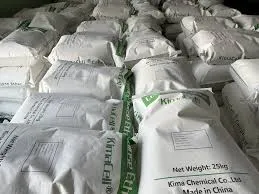
Nov . 07, 2024 22:15 Back to list
Applications and Benefits of Hydroxypropyl Methyl Cellulose in Various Industries
Hydroxypropyl Methyl Cellulose An Overview
Hydroxypropyl Methyl Cellulose (HPMC) is a versatile, non-ionic cellulose ether that plays a crucial role in various industries, including pharmaceuticals, food, and construction. It is synthesized from natural cellulose sources through a series of chemical modifications, namely methylation and hydroxypropylation. HPMC is renowned for its gelling, thickening, and emulsifying properties, making it a valuable ingredient in many formulations.
Chemical Composition and Properties
HPMC is derived from the cellulose plant fiber, which is a natural polymer. The substitution of hydroxyl groups in cellulose with hydroxypropyl and methyl groups creates HPMC, resulting in altered physical and chemical properties. The ratio of hydroxypropyl to methyl groups can be adjusted during synthesis, which allows manufacturers to tailor the properties of HPMC for specific applications. The molecular weight of HPMC can also vary significantly, impacting its solubility and performance.
One of the key characteristics of HPMC is its water solubility. Unlike traditional cellulose, HPMC is soluble in cold water, forming a clear, viscous solution. This property is essential in various applications where thickening and stabilization are required. HPMC solutions exhibit pseudoplastic behavior, meaning they become less viscous when subjected to shear stress—a useful trait for many industrial processes.
Applications in Pharmaceuticals
In the pharmaceutical sector, HPMC is widely used as an excipient. It serves as a binder in tablet formulations, improving the cohesiveness of powder mixtures. Furthermore, HPMC is commonly used in controlled-release drug delivery systems. Its ability to form gels in the presence of moisture allows for the gradual release of active pharmaceutical ingredients (APIs), enhancing therapeutic efficacy and minimizing side effects.
HPMC also finds application in the production of capsule shells and as a coating agent for tablets. Its film-forming capabilities help protect APIs from moisture and light while improving the stability and appearance of the final product.
hydroxypropyl methyl cellulose cas

Role in Food Industry
In the food industry, HPMC acts as a thickening agent, stabilizer, and emulsifier. It is often used in gluten-free products to improve texture and moisture retention. HPMC can mimic some of the functional properties of gluten, making it a suitable substitute in baking applications. Additionally, it is commonly used in sauces, dressings, and dairy products to enhance viscosity and prevent separation.
The food-grade version of HPMC is safe for consumption and is recognized as a suitable additive, often referred to as E464 in the European food additive classification system. Its ability to provide a smooth mouthfeel and enhance product stability enhances the overall sensory experience for consumers.
Construction and Other Applications
Beyond the pharmaceutical and food industries, HPMC is also an important ingredient in construction materials, particularly in the formulation of cement and gypsum-based products. It improves the workability of mortars, plaster, and tile adhesives, allowing for better adhesion and flexibility. Additionally, HPMC contributes to the water-retention properties of these materials, which helps ensure proper curing and reduces the likelihood of cracking.
Furthermore, HPMC is employed in personal care products, such as shampoos and conditioners, as a thickener and stabilizer. It enhances the texture of creams and lotions, providing a smooth application experience.
Conclusion
Hydroxypropyl Methyl Cellulose is an essential ingredient spanning multiple industries due to its unique properties and versatility. Its ability to act as a thickening agent, emulsifier, and stabilizer makes it invaluable in formulations for pharmaceuticals, food, construction, and personal care products. As industries continue to innovate and seek sustainable alternatives, the demand for HPMC is likely to grow, highlighting the importance of this cellulose derivative in modern formulations. Understanding HPMC's properties and applications will pave the way for new developments and enhance its role in diverse sectors.
-
Versatile Hpmc Uses in Different Industries
NewsJun.19,2025
-
Redispersible Powder's Role in Enhancing Durability of Construction Products
NewsJun.19,2025
-
Hydroxyethyl Cellulose Applications Driving Green Industrial Processes
NewsJun.19,2025
-
Exploring Different Redispersible Polymer Powder
NewsJun.19,2025
-
Choosing the Right Mortar Bonding Agent
NewsJun.19,2025
-
Applications and Significance of China Hpmc in Modern Industries
NewsJun.19,2025







